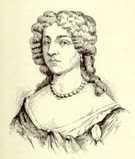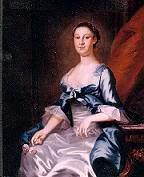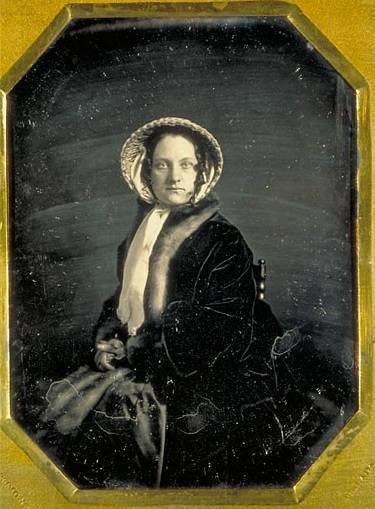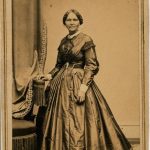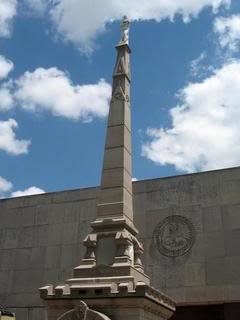Mother of George Washington
Mary Ball Washington, the mother of George Washington, was an intrepid 18th century woman who raised five children alone. The oldest became the first President of the United States. George Washington paid his last visit to his mother at the house in Fredericksburg in April 1789, en route to New York for his inauguration.
Early Life
Mary Ball was born in 1708 in Lancaster County, Virginia. She was the only child of Joseph Ball and his second wife, Mary Johnson. Joseph died a few years after his daughter was born, and soon after, Mary Johnson Ball married Richard Hewes.
Mary Ball grew up learning the lessons every lady should know – sewing, knitting, and cooking. Her mother also instilled in her the lessons of the Church. By the time Mary Ball was thirteen, both of her parents had died.
Mary spent the next nine years dividing her time between Elizabeth Bonum, her half sister from a previous marriage and Colonel George Eskridge, her guardian. Little is known of these years, but Mary Ball may have been tutored in some studies with the other children on the Eskridge plantation.
Marriage
Family tradition tells that Mary Ball traveled to Stratford-by-Bow just outside London when she was about twenty years old. During her visit with her half brother, Joseph Ball, she became better acquainted with Augustine Washington, who lived in the same county and was visiting London at the same time.
On March 6, 1731, Mary married Augustine Washington. She was about 23, which was somewhat old for a first marriage by the standards of the day. Augustine was also from a family that had been in the colony since the mid-1600s, and he had been educated in England, as was the custom of the day. He was a well-established widower, fourteen years her senior, with three children: Lawrence, Augustine, and Jane.
The Washingtons made their home at Pope’s Creek Plantation on the Potomac River in Westmoreland County. This was just one of several farms owned by Augustine Washington. Mary had brought several properties to the marriage as her dowry. The new Mrs. Washington undertook raising her husband’s three children from his previous marriage.
Motherhood
Like many women of America’s Colonial period, Mary Ball Washington lived a life of constant childbearing under harsh conditions. She bore six children in eight years; and, except for the baby daughter born in 1739, all her children survived, far below the mortality rate of the time. During her four years at Augustine’s Pope’s Creek farm, Mary had her first three children – George, Betty, and Samuel.
Then, Augustine moved his second family to Little Hunting Creek, which was later inherited by his eldest son, Lawrence, who named it Mount Vernon. It was a 2500-acre tract he had acquired from his sister Mildred, which had been left to her by their father.
In the summer of 1736, Augustine was off to England for the better part of a year, on business with the Principio Company. By now, there were four small children in their Hunting Creek home.
Ferry Farm
In 1738, Augustine purchased Ferry Farm, a plantation on the banks of the Rappahannock River opposite Fredericksburg, so he would be closer to his iron business. This was the boyhood home of George Washington. The move was in the dead of winter, and there was a new addition to the family, the infant Charles, and another on the way. Baby Mildred arrived in June, but died at 16 months.
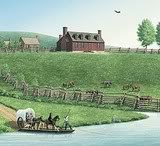
Image: Washington’s Ferry Farm
Artist’s rendering by L.H. Barker, 2008
The plantation was renowned for farming, fishing, and the ferry that crossed the Rappahannock River. George was six years old when they moved, and he received his formal education during his years there, and forged friendships in the neighborhood that would last the rest of his life.
Although the ferry was situated on their property, it was not owned or operated by the Washingtons.
The move brought Augustine Washington closer to Accokeek Iron Furnace – six miles north of Ferry Farm on a tributary of the Potomac River – where he was a managing partner for the Principio Company. Augustine also held political office.
Widowhood
In 1743, Augustine died unexpectedly at the age of 49, leaving Mary a widow at age 35. She farmed the plantation with the help of her enslaved laborers, reared her children alone on the farm and remained after the last child left in 1758. Unlike most widows in Virginia at the time, Mary Ball Washington never remarried.
In his will, Augustine Washington provided a parcel of land to each of his sons, leaving the Ferry Farm and ten slaves to George, to be inherited when he turned 21, to be managed by his mother until that time. Augustine’s sons by his first marriage, Lawrence and Augustine, Jr. also inherited part of the estate. The older sons were already out of the house, and so George became “the man of the house” at a young age.
Mary Ball Washington was by no means destitute, but her security was suddenly very much compromised by the death of her husband. She was promised an income for a period of five years from Ferry Farm, until the property was transferred to George, but she continuously worried about money.
Mary had an independent spirit, which may have helped her overcome some of the problems faced by an 18th century single mother. As the years passed, Mary energetically managed the 600-acre farm. When necessary, she could be a stern parent, as illustrated by her refusal to allow George to join the British Navy.
George Washington continued to call Ferry Farm home until 1754, when he moved to Mount Vernon while his mother stayed on at the farm.
Senior Years
Mary’s son-in-law Fielding Lewis built her a house in Fredericksburg, Virginia, in 1761, on a lot that George Washington had bought. But it was another decade before her grown children finally convinced her to leave the farm. Mary was then 64, and the farm was becoming too much of a task.
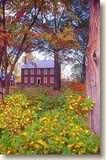
Image: Kenmore Plantation
From Mary’s Fredericksburg home, she was within walking
distance of her daughter and son-in-law Betty and
Fielding Lewis at Kenmore Plantation.
Mary Ball Washington spent her last seventeen years in that white frame house on the corner of Charles and Lewis Streets in Fredericksburg. The Marquis de Lafayette, French hero of the American Revolution and George’s friend, would visit her in this home.
Although she may have been reluctant to accept town life, Mary was fortunate in her neighbors. Nearby were James Mercer, a lawyer and family friend; Dr. Hugh Mercer, the family physician; and Charles Dick, a member of the family circle for more than a quarter of a century.
The Revolutionary War
When the War for Independence began, it brought with it great anxiety for her son, who would have faced severe punishment if the Colonies’ effort failed. General George Washington took command of the Continental Army in June 1775, and Mary didn’t see him for nearly 10 years.
Virginia’s critical war years began in 1780 when the British launched a southern campaign. Fredericksburg was twice threatened early in 1781, which caused the ailing Fielding Lewis to flee with his family and his mother-in-law to Berkeley County, where they lived with Fielding Jr. for many months. During their stay Lewis died and was buried on the 1000-acre estate he had given his son.
Mary Washington and her newly widowed daughter returned to Fredericksburg to pick up the pieces of their lives. We have a glimpse of her unpretentious lifestyle in the description by the tutor at James Mercer’s nearby residence: “Active and sprightly she goes about the neighborhood on foot with a cane in her hand to visit our quality. She lives in a house of one story without the slightest affectation of magnificence.”
Perhaps Mary’s proudest moment came during the visit her son made in February 1784, when he accepted the honors of the town and responded with a declaration honoring “my revered mother by whose maternal hand, early deprived of a father, I was led to manhood.”
George Elected President
Mary’s last years were plagued with pain and illness. A life-threatening attack in the spring of 1787 brought Washington in haste from Mount Vernon, but she rallied. Mary lived to see her son elected President. George paid his last visit to his mother at the house in Fredericksburg in April 1789, en route to New York for his inauguration.
Washington always acknowledged that he owed everything to his mother – the education and habits of his early life, his high moral principle, his perfect self-possession, his clear and sound judgment, his inflexible resolution and untiring application – all were developed by her training and example.
She loved to speak, in her latter days, of her son’s merits in his early life, and of his filial affection and duty; but never dwelt on the glory he had won as the deliverer of his country, the chief magistrate of a great republic.
Mary Ball Washington died August 25, 1789. Her final lengthy illness from cancer ended her life at the age of 81. She is buried near Kenmore, the home of Betty and Fielding Lewis, a few steps from Meditation Rock, which was her favorite retreat for reading, prayer and meditation.
Members of Congress wore black crepe armbands for Mary for 30 days, and passed a resolution to erect a monument on her grave. However, when Lafayette returned to Fredericksburg in 1825, he saw only an uncared-for small marble tombstone in the middle of a cornfield.
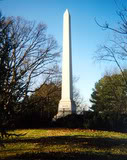
Image: Mary Washington Monument
There are now many monuments to Mary Ball Washington in Fredericksburg, Virginia. The house purchased for her by her son George contains a fine collection of antique furnishings. A monument was erected in 1833 and dedicated by President Andrew Jackson, but was left unfinished until a new one was dedicated by President Grover Cleveland in 1894.
SOURCES
Ferry Farm History
Washington’s Boyhood
Wikipedia: Mary Ball Washington
In Search of the Real Mary Ball Washington
The Women of the American Revolution/Mary Washington
